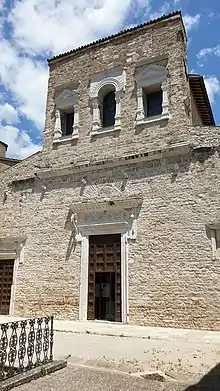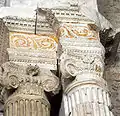Basilica of San Salvatore, Spoleto
San Salvatore is a romanesque-style, former basilica church located in the center of Spoleto, Province of Perugia, region of Umbria, Italy.

The Lombards’ renovation of the church dates back to the eighth century and it is testimony to the architectural style of the Longobardia Minor, “marking the transition from Antiquity to the European Middle Ages”.[1]
In 2011 was declared a UNESCO world heritage property as part of the serial property “Longobards in Italy. Places of the power (568-774 A.C.)”, which comprises seven sites throughout Italy characterized by lombard elements of architecture, painting, sculpture and art. Beside the nearby Clitunno Tempietto (PG), the other five sites are: the castrum with the Torba Tower and the church outside the walls Santa Maria foris portas (VA), the monumental area with the monastic complex of San Salvatore-Santa Giulia (BS), the Gastaldaga area and the Episcopal complex (UD), the Santa Sofia complex (BN) and the Sanctuary of San Michele (FG). San Salvatore is located in the monumental cemetery of Spoleto, upon Ciciano hill, outside the medieval town walls. The cemetery was designed in 1836 by the architect Ireneo Aleandri.[2]
History
There is no official document that reveals the precise date of the basilica’s construction. Among the various hypothesis the most accepted one is that the building dates back to the end of IV century and the beginning of the V century and was built on a Romanesque house, around the burial site of the Saint Concordio, who was an early Christian martyr under Marcus Aurelius’s dominion. The basilica is characterized by western Christian elements along with eastern elements, the latter probably made by the Syriac monks, who arrived in Spoleto in the IV century.
At the beginning the church was dedicated to Saint Concordio. During the VIII century, the building was renovated by the Lombards after damages caused by unknown causes and it was called San Salvatore in 814, which was quite common for Early Middle Age churches. In the XI century it regained the original denomination until 1600 when it was denominated Chiesa del Crocifisso due to the scene of the Crucifixion positioned above the altar. Eventually, during the XX century it regained the current denomination despite the fact that restoration works in 1906, 1919-21, 1938, 1950 removed changes carried out over the centuries and restored elements of Early Christianity.
Architecture
The Basilica of San Salvatore, probably associated to funerary functions, has three naves. The presbytery is tripartite as well and covered by an octagonal-based vault. The apse is semicircular and is externally closed by a straight wall; on the sides there are two apsidal rooms with a cross vault.
The interior has lost its original stucco decoration but retains the rich entablature with Doric frieze, set on Doric (in the nave) or Corinthian (in the presbytery) columns.
The rich decoration and triangular pediment of the original 8th century facade, marked by pilasters and divided into two orders by a frame, have been lost, except for the window frames and the three portals carved with classical motifs. The latter, coming from waste material, were obtained from pre-existing Roman buildings, as frequently happened in Lombard works.
Despite the unwillingness of the Dukes to welcome the contemporary ancient renaissance that was taking place in Rome, the restoration of the church carried out by the Lombards, as already in the Clitunno Tempietto, achieved an exceptional classical coherence, both in the architectural structure marked by the columns of the nave and presbytery, and in the reproduction of Roman decorative elements.
Gallery
 The exterior of the church
The exterior of the church The main facade
The main facade The interior of the church
The interior of the church Detail of the architrave
Detail of the architrave Detail of the interior
Detail of the interior Detail of the capitals
Detail of the capitals
References
- Centre, UNESCO World Heritage. "Longobards in Italy. Places of the Power (568-774 A.D.)". UNESCO World Heritage Centre. Retrieved 2020-12-16.
- http://www.comune.spoleto.pg.it/turismoecultura/itinerari/itinerari-urbani/i-10-luoghi-da-non-perdere/basilica-di-san-salvatore-e-cimitero-monumentale/
